_______________
Additional Photos

interior
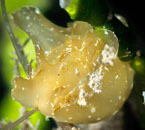
front, pale yellow
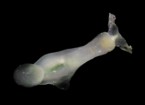
underside
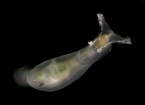
young, 7 mm

young, spotted
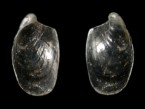
young shell

|
Aplysia juliana Quoy & Gaimard, 1832
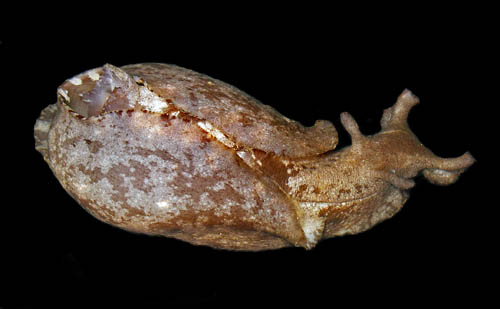
Maximum size: about 150 mm
(most much smaller).
Identification:
This
sea
hare
is
usually light
olive
to
brown
with
darker
brown
blotches on the
sides of the parapodia. Younger animals are usually lighter in color
with
larger brown blotches. However, some may lack spots completely and/or
have a pale yellow background. A line of white flecks often passes
through the eye spot and there are sometimes white patches on the
parapodia and rhinophore tips. The posterior
portion of the foot forms a
distinctive sucker.
Natural history:
Aplysia juliana is
a moderately common species that is largely restricted to rocky
habitats where there is an extensive growth of the green alga Ulva
on which it feeds. It usually occurs
at depths of < 1 to 2 m (< 3 to 6 ft) at protected to moderately
exposed locations, often where there is some fresh water and nutrient
seepage. Rarely, it may be found at other sites at up to 7 m (24 ft).
It's nocturnal, concealing itself under rocks during the day.
The posterior sucker on the foot allows it to cling to algae and rocks,
crawling "inch-worm fashion." It ejects a milky white fluid when
disturbed and lays a tangled, yellowish-brown egg mass that is usually
attached to the underside of a rock.
Distribution:
Maui and Oahu (also Johnston Atoll?): circumtropical.
Taxonomic notes:
Aplysia sandvicensis
Sowerby, 1869 is a synonym (Kay, 1979). It's referred to as "Juliana's
sea hare" in Hoover, 1998 & 2006. It
was first reported from Hawaii in Pease, 1860 (as Syphonota bipes) and is listed as Tethys bipes in Edmondson, 1946 and Ostegaard, 1950.
Photo: CP:
100 mm: found by PF; on beach fronting Halama St., Kihei, Maui; March
12, 2011.
Observations and comments:
Note
1: ( )
|
|







